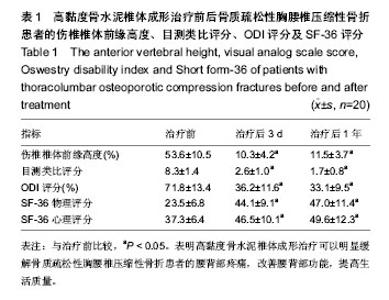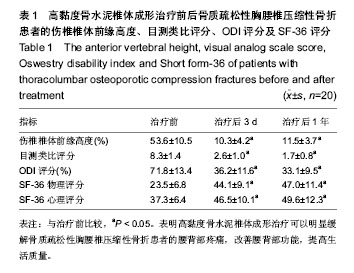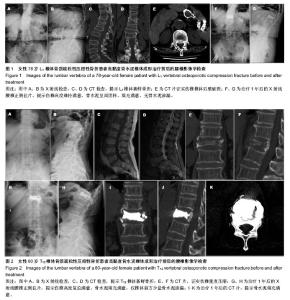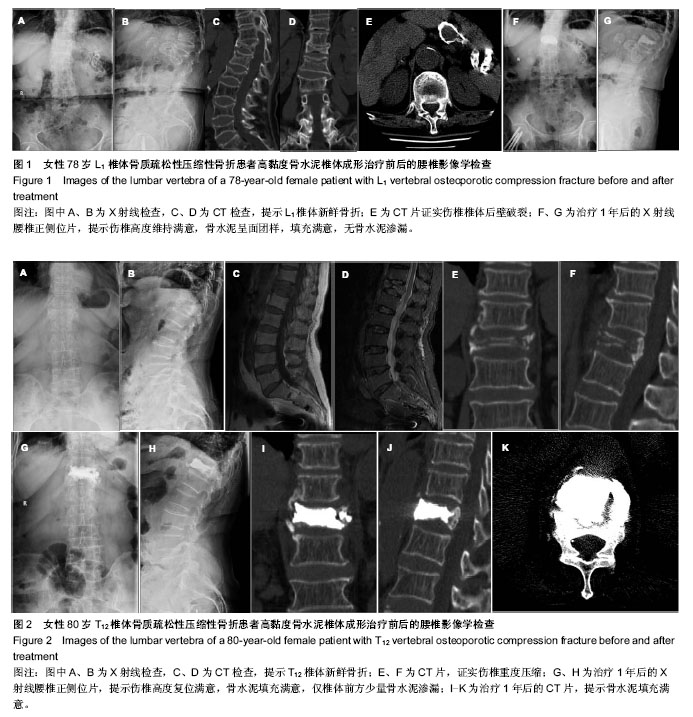Chinese Journal of Tissue Engineering Research ›› 2014, Vol. 18 ›› Issue (30): 4757-4763.doi: 10.3969/j.issn.2095-4344.2014.30.001
Application of high viscosity bone cement in thoracolumbar osteoporotic compression fractures
Feng Xin-min, Wang Jing-cheng, Zhang Liang, Tao Yu-ping, Yang Jian-dong, Cai Jun, Zhang Sheng-fei, Huang Ji-jun
- Northern Jiangsu People’s Hospital, Yangzhou 225001, Jiangsu Province, China
-
Revised:2014-06-10Online:2014-07-16Published:2014-08-08 -
Contact:Zhang Liang, Attending physician, Lecturer, Northern Jiangsu People’s Hospital, Yangzhou 225001, Jiangsu Province, China -
About author:Feng Xin-min, Master, Chief physician, Associate professor, Northern Jiangsu People’s Hospital, Yangzhou 225001, Jiangsu Province, China -
Supported by:grants from the Development Center for Medical Science and Technology, Ministry of Health, No. W2012ZT14; Natural Science Foundation of Jiangsu Province for Youths, No. 20140496 BK; Program for the Talents in Science and Education of Yangzhou, China
CLC Number:
Cite this article
Feng Xin-min, Wang Jing-cheng, Zhang Liang, Tao Yu-ping, Yang Jian-dong, Cai Jun, Zhang Sheng-fei, Huang Ji-jun. Application of high viscosity bone cement in thoracolumbar osteoporotic compression fractures[J]. Chinese Journal of Tissue Engineering Research, 2014, 18(30): 4757-4763.
share this article

2.1 参与者数量分析 20例患者均顺利完成手术,完成1年以上随访,按意向性处理分析,20例均进入结果分析。 2.2 伤椎椎体前缘高度恢复 治疗后患者伤椎椎体前缘高度得到明显改善,由治疗前的(53.6±10.5)%到治疗后 3 d的(10.3±4.2)%和治疗后1年的(11.5±3.7)%,治疗前后椎体高度比较差异有显著性意义(P < 0.05),治疗后3 d和治疗后1年椎体高度比较差异无显著性意义(P > 0.05),见表1。 2.3 腰背部疼痛及功能恢复情况 术后腰背部疼痛明显缓解或消失,腰背部功能明显改善,生活质量评分得到明显提高,治疗后3 d及1年的目测类比评分、ODI评分明显低于治疗前(P < 0.05),治疗后3 d和治疗后1年的目测类比评分、ODI评分比较差异无显著性意义(P > 0.05)。治疗后3 d及1年的SF-36物理评分及心理评分均高于术前(P < 0.05),治疗后3 d和治疗后1年的SF-36物理评分及心理评分比较差异无显著性意义(P > 0.05),见表1。治疗后神经功能均正常为Frankle E级,与治疗前相同。 2.4 并发症及不良反应 所有手术均顺利完成,每个椎体注射骨水泥量2-5 mL,术中血压及血氧饱和度均正常。治疗后随访12-18个月,平均14.5个月。术后复查X射线及CT见骨水泥弥散良好,只有1例发生椎管内少量骨水泥渗漏及1例椎体前方渗漏,但无任何临床症状,无骨水泥毒性或过敏反应、肺栓塞、感染和神经损伤等并发症发生。随访期间无新发骨折。"

| [1] Lange A,Kasperk C,Alvares L,et al.Survival and Cost Comparison of Kyphoplasty and Percutaneous Vertebroplasty Using German Claims Data.Spine (Phila Pa 1976). 2013; 39(4): 318-326. [2] Liu J,Li X,Tang D,et al.Comparing pain reduction following vertebroplasty and conservative treatment for osteoporotic vertebral compression fractures: a meta-analysis of randomized controlled trials. Pain Physician. 2013;16(5): 455-464. [3] Kim JH,Yoo SH.Long-term Follow-up of Percutaneous Vertebroplasty in Osteoporotic Compression Fracture: Minimum of 5 Years Follow-up. Asian Spine J. 2012; 6(1): 6-14. [4] Kim KW,Cho KJ,Kim SW,et al.A nation-wide, outpatient-based survey on the pain, disability, and satisfaction of patients with osteoporotic vertebral compression fractures.Asian Spine J. 2013;7(4):301-307. [5] Chen D,An ZQ,Song S,et al.Percutaneous vertebroplasty compared with conservative treatment in patients with chronic painful osteoporotic spinal fractures.J Clin Neurosci. 2014; 21(3):473-477. [6] Lee YK,Jang S,Lee HJ,et al.Mortality after vertebral fracture in Korea: analysis of the National Claim Registry.Osteoporos Int.2012;23(7):1859-1865. [7] 史光华,李鹏翠,卫小春.骨质疏松椎体压缩骨折的治疗进展[J].中国骨伤, 2013,26(10):878-882. [8] Wu ZX,Gao MX,Sang HX,et al.Surgical treatment of osteoporotic thoracolumbar compressive fractures with open vertebral cement augmentation of expandable pedicle screw fixation: a biomechanical study and a 2-year follow-up of 20 patients. J Surg Res.2012;173(1):91-98. [9] Yu CW,Hsieh MK,Chen LH,et al.Percutaneous balloon kyphoplasty for the treatment of vertebral compression fractures. BMC Surg.2014;14:3. [10] 柳申鹏,刘中何,赵斌,等.骨水泥植入经皮椎体成形治疗胸腰椎体骨折[J].中国组织工程研究,2012,16(29):5465-5468. [11] 徐建成,白靖平,锡林宝勒日,等.注入骨水泥椎体成形与非手术治疗骨质疏松性椎体压缩骨折的Meta分析[J].中国组织工程研究与临床康复,2011,15(13):2366-2370. [12] Hulme PA,Krebs J,Ferguson SJ,et al.Vertebroplasty and kyphoplasty: a systematic review of 69 clinical studies.Spine (Phila Pa 1976).2006;31(17):1983-2001. [13] Chen WJ,Kao YH,Yang SC,et al.Impact of cement leakage into disks on the development of adjacent vertebral compression fractures. Journal of spinal disorders & techniques. 2010;23(1):35-39. [14] Chen X,Ren J,Zhang J,et al.Impact of Cement Placement and Leakage in Osteoporotic Vertebral Compression Fractures Followed by Percutaneous Vertebroplasty. J Spinal Disord Tech.2013.[Epub ahead of print] [15] Venmans A,Lohle P,Van Rooij W,et al.Frequency and outcome of pulmonary polymethylmethacrylate embolism during percutaneous vertebroplasty.AJNR Am J Neuroradiol. 2008;29(10):1983-1985. [16] Ha KY,Kim YH,Chang DG,et al.Causes of late revision surgery after bone cement augmentation in osteoporotic vertebral compression fractures.Asian Spine J.2013;7(4): 294-300. [17] He SC,Teng GJ,Deng G,et al.Repeat vertebroplasty for unrelieved pain at previously treated vertebral levels with osteoporotic vertebral compression fractures.Spine (Phila Pa 1976).2008;33(6):640-647. [18] 吴梅祥,白波,吴景明,等.骨质疏松椎体压缩性骨折椎体成形术后失败的原因与对策[J].中国创伤骨科杂志,2011,13(9):893-895. [19] Nieuwenhuijse MJ,Van Erkel AR,Dijkstra PD.Cement leakage in percutaneous vertebroplasty for osteoporotic vertebral compression fractures: identification of risk factors.Spine J.2011;11(9):839-848. [20] Nieuwenhuijse MJ,Muijs SP,van Erkel AR,et al.A clinical comparative study on low versus medium viscosity polymethylmetacrylate bone cement in percutaneous vertebroplasty: viscosity associated with cement leakage. Spine (Phila Pa 1976).2010; 35(20):E1037-1044. [21] Baroud G,Crookshank M,Bohner M.High-viscosity cement significantly enhances uniformity of cement filling in vertebroplasty: an experimental model and study on cement leakage.Spine (Phila Pa 1976).2006;31(22):2562-2568. [22] Anselmetti GC,Zoarski G,Manca A,et al.Percutaneous vertebroplasty and bone cement leakage: clinical experience with a new high-viscosity bone cement and delivery system for vertebral augmentation in benign and malignant compression fractures.Cardiovasc Intervent Radiol. 2008; 31(5):937-947. [23] 李春海,刘尚礼,叶伟,等.高黏度骨水泥在经皮椎体成形术中的应用[J].中华骨科杂志,2007,27(4):259-262. [24] Stevenson M,Gomersall T,Lloyd Jones M,et al.Percutaneous vertebroplasty and percutaneous balloon kyphoplasty for the treatment of osteoporotic vertebral fractures: a systematic review and cost-effectiveness analysis.Health Technol Assess.2014;18(17):1-290. [25] Xing D,Ma JX,Ma XL,et al.A meta-analysis of balloon kyphoplasty compared to percutaneous vertebroplasty for treating osteoporotic vertebral compression fractures.J Clin Neurosci.2013;20(6):795-803. [26] 蔺福辉,易小波,任志宏.高粘度骨水泥在椎体成形术中的应用[J].中国骨与关节损伤杂,2009,24(1):66-67. [27] Bergmann M,Oberkircher L,Bliemel C,et al.Early clinical outcome and complications related to balloon kyphoplasty. Orthop Rev (Pavia).2012;4(2):e25. [28] Georgy BA.Feasibility, safety and cement leakage in vertebroplasty of osteoporotic and malignant compression fractures using ultra-viscous cement and hydraulic delivery system.Pain Physician.2012;15(3):223-228. [29] 彭小忠,陈明,武振国,等.经皮椎体成形102例中22例骨水泥渗漏原因[J].中国组织工程研究与临床康复,2011,15(8):1515-1518. [30] Lee MJ,Dumonski M,Cahill P,et al.Percutaneous treatment of vertebral compression fractures: a meta-analysis of complications.Spine (Phila Pa 1976).2009; 34(11):1228-1232. [31] 王永祥,王广斌,王静成,等.椎体成形术治疗骨质疏松性椎体骨折的并发症及防治[J].中国骨质疏松杂志,2010,16(11):855-858. [32] Lee KA,Hong SJ,Lee S,et al.Analysis of adjacent fracture after percutaneous vertebroplasty: does intradiscal cement leakage really increase the risk of adjacent vertebral fracture? Skeletal Radiol.2011;40(12):1537-1542. [33] Komemushi A,Tanigawa N,Kariya S,et al.Percutaneous vertebroplasty for osteoporotic compression fracture: multivariate study of predictors of new vertebral body fracture.Cardiovasc Intervent Radiol.2006;29(4):580-585. [34] 汪宇,刘先银,郭建恩,等.椎体后凸成形与后伸体位恢复骨质疏松性压缩骨折椎体高度12例[J].中国组织工程研究与临床康复, 2009,13(26):5167-5170. |
| Viewed | ||||||
|
Full text |
|
|||||
|
Abstract |
|
|||||

